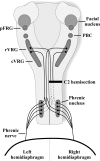Effect of spinal cord injury on the respiratory system: basic research and current clinical treatment options
- PMID: 17853653
- PMCID: PMC2031930
- DOI: 10.1080/10790268.2007.11753947
Effect of spinal cord injury on the respiratory system: basic research and current clinical treatment options
Abstract
Spinal cord injury (SCI) often leads to an impairment of the respiratory system. The more rostral the level of injury, the more likely the injury will affect ventilation. In fact, respiratory insufficiency is the number one cause of mortality and morbidity after SCI. This review highlights the progress that has been made in basic and clinical research, while noting the gaps in our knowledge. Basic research has focused on a hemisection injury model to examine methods aimed at improving respiratory function after SCI, but contusion injury models have also been used. Increasing synaptic plasticity, strengthening spared axonal pathways, and the disinhibition of phrenic motor neurons all result in the activation of a latent respiratory motor pathway that restores function to a previously paralyzed hemidiaphragm in animal models. Human clinical studies have revealed that respiratory function is negatively impacted by SCI. Respiratory muscle training regimens may improve inspiratory function after SCI, but more thorough and carefully designed studies are needed to adequately address this issue. Phrenic nerve and diaphragm pacing are options available to wean patients from standard mechanical ventilation. The techniques aimed at improving respiratory function in humans with SCI have both pros and cons, but having more options available to the clinician allows for more individualized treatment, resulting in better patient care. Despite significant progress in both basic and clinical research, there is still a significant gap in our understanding of the effect of SCI on the respiratory system.
Figures

References
-
- National Spinal Cord Injury Statistical Center Spinal cord injury: facts and figures at a glance. J Spinal Cord Med. 2006;29:89–90.
-
- Epstein SK, Nevins ML. Prolonged mechanical ventilation. In: Mosenfifar Z, Soo Hoo GW, editors. Practical Pulmonary and Critical Care Medicine: Respiratory Failure. Lung Health in Biology and Disease. New York: Taylor and Francis Group; 2006. pp. 187–217.
-
- Jackson AB, Groomes TE. Incidence of respiratory complications following spinal cord injury. Arch Phys Med Rehabil. 1994;75:270–275. - PubMed
-
- Claxton AR, Wong DT, Chung F, Fehlings MG. Predictors of hospital mortality and mechanical ventilation in patients with cervical spinal cord injury. Can J Anaesth. 1998;45:144–149. - PubMed
-
- Fishburn MJ, Marino RJ, Ditunno JF., Jr. Atelectasis and pneumonia in acute spinal cord injury. Arch Phys Med Rehabil. 1990;71:197–200. - PubMed
Publication types
MeSH terms
Grants and funding
LinkOut - more resources
Full Text Sources
Medical
Miscellaneous
